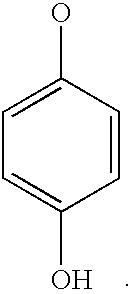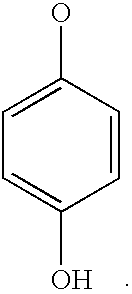Process for the isolation of a major harmful oxidant from cigarette smoke
a technology of cigarette smoke and oxidant, which is applied in the field of isolation and characterization of major harmful oxidants, can solve the problems of cigarette smoke major harmful oxidants, meagre concentration of benzo [a] pyrene in cigarette smoke, and perplexing to conceive how
- Summary
- Abstract
- Description
- Claims
- Application Information
AI Technical Summary
Problems solved by technology
Method used
Image
Examples
example 1
[0121] Isolation and Purification of a Major Hazardous Component (cs-oxidant) from Cigarette Tar or Whole Cigarette Smoke Solution
[0122] (i). Five Indian commercial filter-tipped cigarette (74 mm) with a tar content of 25 mg each was mounted in glass tubes that penetrated the hole in the glass stopper of a one liter glass Erlenmeyer flask with a side arm and ended about 2 cm away from the bottom of the flask. The flask was dipped in a mixture of ice and salt and the side arm connected to a water pump. The cigarettes were lit and the tar was allowed to condense and settle at the bottom of the flask. Altogether tar from twenty cigarettes was collected. The jar was taken out to room temperature and the tar was extracted with 20 ml of 50 mM potassium phosphate buffer pH 7.4. The solution was filtered through 0.45 .mu.m Millipore filter. The pH of the filtrate was adjusted to 7.4 with addition of 20 .mu.l of 2N NaOH solution. The colour of the solution was brownish yellow. This solution ...
example 2
[0154] Quantitative Assay of Protein Damage by Measuring Carbonyl Content.
[0155] The incubation system contained 1 mg BSA and 50 .mu.l of cs solution or its equivalent amounts obtained at different stages of purification in a final volume of 200 .mu.l of 50 mM potassium phosphate buffer, pH 7.4. The incubation was carried out at 37.degree. C. for 1 hour. Protein carbonyl was measured by reaction with 2,4-dinitrophenyl hydrazine (DNPH) following the method of Levine et al (Methods Enzymol. 186: 464-478, 1990) similar to that done before in our laboratory (Panda et al., Free Radic. Biol. & Med. 27: 1064-1079, 1999). After incubation of BSA with whole phase cs solution, the aqueous extract of cs or the cs-oxidant (final volume 200 .mu.l ), the proteins were precipitated with 200 .mu.l of 20% trichloroacetic acid solution followed by a wash with 200 .mu.l of 10% trichloroacetic acid solution to free the pellet of cs components. To this washed pellet was then added 500 .mu.l of 10 mM DNP...
example 3
[0156] Physico-chemical Properties of the cs-oxidant
[0157] (a) Appearance: When crystallized from acetone solution, the oxidant appeared as small needle shaped faint yellow coloured crystals (FIG. 8). In the dry condition or in solution, the compound gradually turns brown in air under light.
[0158] (b) Odour: Pungent smell, similar to that of rancid butterfat.
[0159] (c) UV absorption: The oxidant has two absorption maxima in methanol solution, one at 293.4 nm and another at 223.0 nm (FIG. 9). In aqueous solution, the absorption maxima are at 288 nm and 221 nm. There was no absorption in the visible region of 400 nm to 700 nm indicating that the oxidant lacks chromophoric group.
PUM
| Property | Measurement | Unit |
|---|---|---|
| pressure | aaaaa | aaaaa |
| temperature | aaaaa | aaaaa |
| temperature | aaaaa | aaaaa |
Abstract
Description
Claims
Application Information
 Login to View More
Login to View More - R&D
- Intellectual Property
- Life Sciences
- Materials
- Tech Scout
- Unparalleled Data Quality
- Higher Quality Content
- 60% Fewer Hallucinations
Browse by: Latest US Patents, China's latest patents, Technical Efficacy Thesaurus, Application Domain, Technology Topic, Popular Technical Reports.
© 2025 PatSnap. All rights reserved.Legal|Privacy policy|Modern Slavery Act Transparency Statement|Sitemap|About US| Contact US: help@patsnap.com



